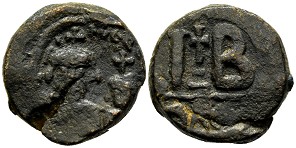Fine Coins Showcase
Antiquities Showcase
Hide empty categories
Shop Search
Shopping Cart
My FORVM
Contact Us
About Forum
Shopping at Forum
Our Guarantee
Payment Options
Shipping Options & Fees
Privacy & Security
Forum Staff
Selling Your Coins
Identifying Your Coin
FAQs
zoom.asp
Home ▸ Catalog ▸ |Byzantine Coins| ▸ |Byzantine Mints| ▸ |Alexandria||View Options:   | | | | | | The long closed mint at Alexandria reopened during the reign of Justin I. The great metropolis was lost to the Arabs in 646 and was never recovered by the Byzantine Empire. |


The Byzantine-Sassanid War ended with a Byzantine victory in 628, but the war, after a century of nearly continuous conflict, left both empires crippled. The Persians suffering economic decline, heavy taxation, religious unrest, dynastic turmoil and other social problems, plunged into civil war. The Byzantines had exhausted their treasure, the Balkans had been largely lost to the Slavs, and Anatolia was devastated. Neither empire was given any chance to recover, as within a few years they were struck by the onslaught of the Arabs, newly united by Islam. The Sassanid Empire would soon be completely destroyed. The Muslim conquest of Syria, Egypt and North Africa, would reduce the Byzantine Empire to a territorial rump consisting of Anatolia and a scatter of islands and footholds in the Balkans and Italy.BZ115113. Bronze 12 nummi, cf. DOC II-1 189; Morrisson BnF p. 293 and pl. XLVI, 10/A1/AE/04; Wroth 289; SBCV 853, F, flan crack, off center, weight 5.204 g, maximum diameter 17.8 mm, die axis 0o, Egypt, Alexandria mint, 613 - 618 A.D.; obverse dom - ERACLI (or similar), facing busts of Heraclius (on left, bearded) and his son Heraclius Constantine, each wears a crown with cross and chlamys; reverse large IB (12 nummi) divided by cross potent on two steps, AΛE
Byzantine Empire, Revolt of the Heraclii, 608 - 5 Oct 610 A.D.


Heraclius the Elder, possibly of Armenian origin, was a Byzantine general and the father of Byzantine emperor Heraclius. He distinguished himself in the war against the Sassanid Persians in the 580s, was a subordinate general under Philippicus during the Battle of Solachon, and possibly served under Comentiolus during the Battle of Sisarbanon. About 595, Heraclius the Elder is mentioned as a magister militum per Armeniam sent by Emperor Maurice to quell an Armenian rebellion led by Samuel Vahewuni and Atat Khorkhoruni. About 600, he was appointed as the Exarch of Africa and in 608, Heraclius the Elder rebelled with his son against the usurper Phocas. Using North Africa as a base, the younger Heraclius managed to overthrow Phocas, beginning the Heraclian dynasty, which would rule Byzantium for a century. Heraclius the Elder died soon after receiving news of his son's accession to the Byzantine throne.BZ86356. Bronze follis, DOC II-2 16, Morrisson BnF 9/Ax/AE/01, Hahn MIBEC 16a, Grierson 164, Tolstoi 279, SBCV 722, Sommer -, Ratto -, VF, rev. a little off center cutting off part of mintmark, scratches, overstruck, weight 11.035 g, maximum diameter 30.4 mm, die axis 180o, 1st officina, Alexandria or Alexandretta mint, Sep - Oct 610 A.D.; obverse dm N ERACLIO CONSULII, facing busts of Heraclius and his father, both bearded, bareheaded and wearing consular robes, cross above center; reverse large M (40 nummi), cross above, ANNO left, X/IIII (year 14) on right, A (1st officina) below, AΛEΖANΔ in exergue; rare; SOLD
Byzantine Empire, Revolt of the Heraclii, 608 - 5 Oct 610 A.D.


Heraclius the Elder, possibly of Armenian origin, was a Byzantine general and the father of Byzantine emperor Heraclius. He distinguished himself in the war against the Sassanid Persians in the 580s, was a subordinate general under Philippicus during the Battle of Solachon, and possibly served under Comentiolus during the Battle of Sisarbanon. About 595, Heraclius the Elder is mentioned as a magister militum per Armeniam sent by Emperor Maurice to quell an Armenian rebellion led by Samuel Vahewuni and Atat Khorkhoruni. About 600, he was appointed as the Exarch of Africa and in 608, Heraclius the Elder rebelled with his son against the usurper Phocas. Using North Africa as a base, the younger Heraclius managed to overthrow Phocas, beginning the Heraclian dynasty, which would rule Byzantium for a century. Heraclius the Elder died soon after receiving news of his son's accession to the Byzantine throne.BZ86357. Bronze follis, DOC II 16, Morrisson BnF 9/Ax/AE/02, Hahn MIBEC 16a, Grierson 164, Tolstoi 279, SBCV 722, Sommer -, Ratto -, aF, uneven strike, a little off center, scratches, overstruck, edge cracks, weight 5.587 g, maximum diameter 29.4 mm, die axis 180o, 1st officina, Alexandria or Alexandretta mint, Sep - Oct 610 A.D.; obverse dm N ERACLIO CONSULII, facing busts of Heraclius and his father, both bearded, bareheaded and wearing consular robes, cross above center; reverse Large M (40 nummi), cross above, ANNO left, X/IIII (year 14) on right, A (1st officina) below, AΛEΖANΔ in exergue; rare; SOLD
CLICK HERE TO SEE MORE FROM THIS CATEGORY - FORVM's PRIOR SALES



MINTMARKS
Page created in 0.968 seconds.








